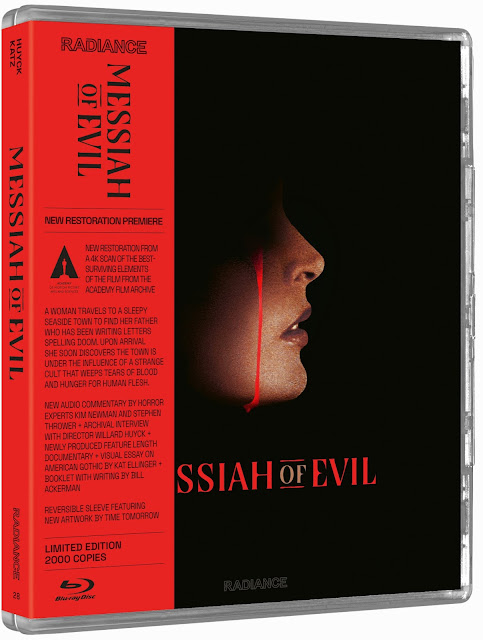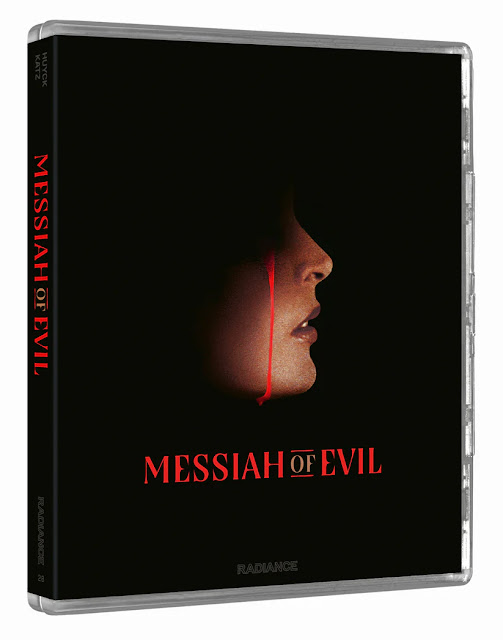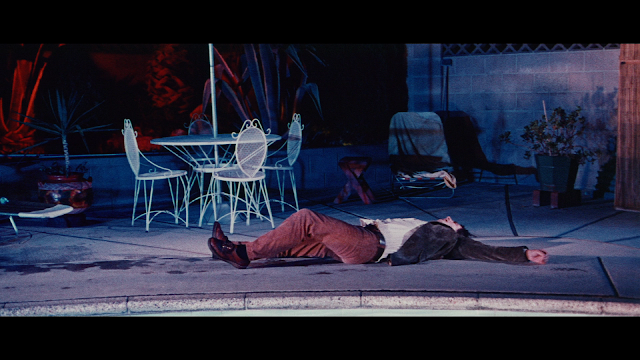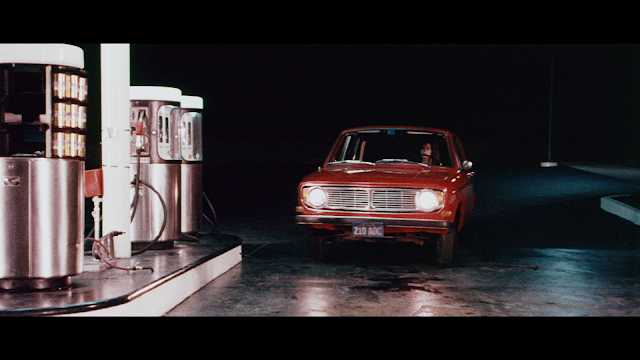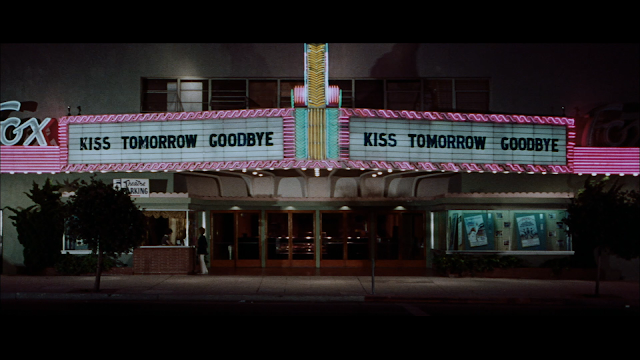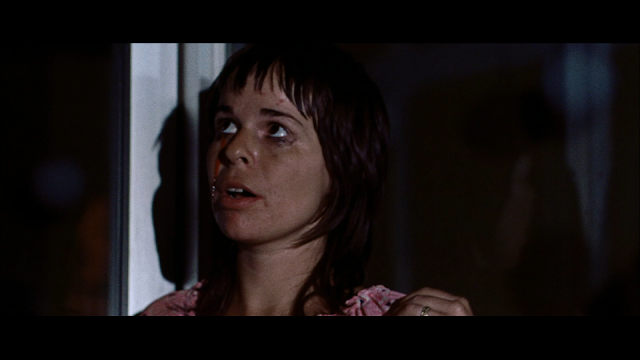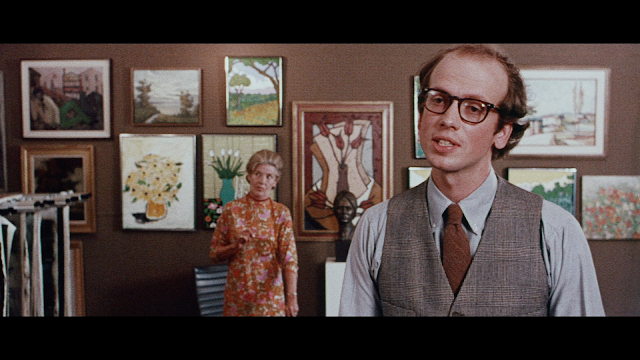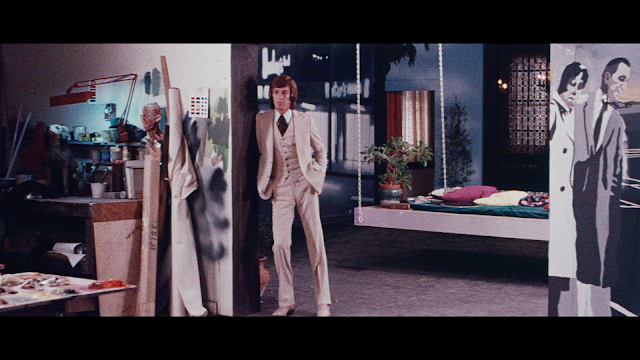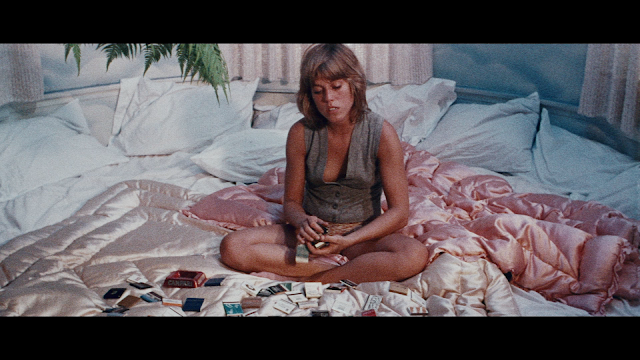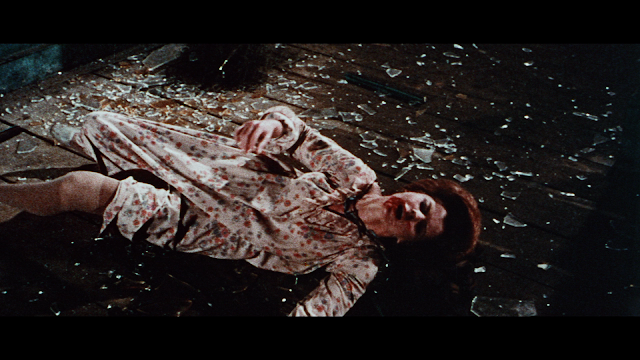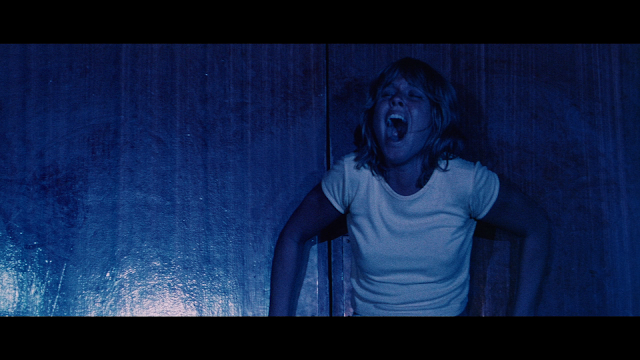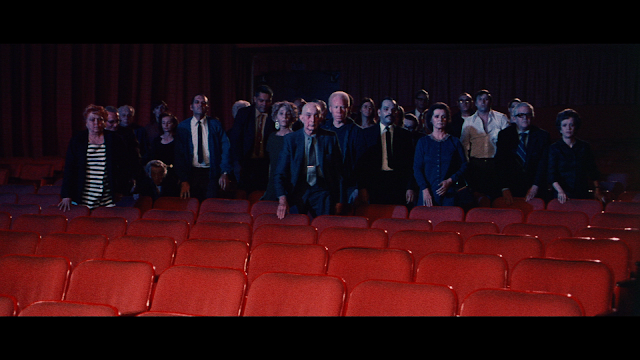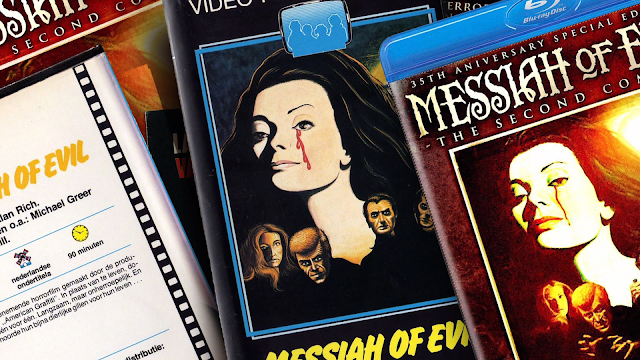MESSIAH OF EVIL (1973)
Special Limited Edition Blu-ray
Label: Radiance Films
Region Code: A,B
Rating: Unrated
Duration: 89 Minutes
Audio: English PCM 2.0 Dual-Mono with Optional English Subtitles
Video: 1080p HD Widescreen (2.35:1)
Director: Willard Huyck
Cast: Marianna Hill, Michael Greer, Anitra Ford, Royal Dano, Elisha Cook Jr.
Messiah of Evil (1971) is an independent American horror film co-produced and co-directed by George Lucas associates Willard Huyck and Gloria Katz, who also were writers of American Grafitti, Indiana Jones and the Temple of Doom and Howard the Duck, the latter of which Willard also directed (and the notorious flop seemingly ended his directing career). In it a young woman named Arletty (Marianne Hill, The Baby) arrives in a sleepy seaside village of Point Dune, CA after receiving unsettling letters from her artist father Joseph (Royal Dano, Ghoulies II), only to discover the place is under the influence of a strange cult of lunar-obsessed, pasty-skinned ghouls that shed tears of blood and hunger for the taste of human flesh, victims of a doomed prophecy.
While searching for her father she stays at his beach house, a bizarre pad with wall-to-wall murals of life-size figures that stare out at you from the dark, which is quite unsettling. There she restlessly reads from his letters which tells of an encroaching numbness that has been overtaking him. She also encounters a wealthy Portuguese man named Thom (Michael Greer, Summer School Teachers) and his two lovely female companions – Laura (Anitra Ford, Invasion of the Bee Girls) and Toni (Joy Bang, Night of the Cobra Woman), who have been drawn to the seaside spot to explore the local folklore, first encountering Thom interviewing a local wino (Elisha Cook Jr., A Haunted Palace) at a hotel. After showing an interest in her father's work he sets his sights on seducing Arletty, much to the dismay of his current female companions.
We also get some backstory about a dark preacher who came to Pint Dune during , a survivor of the notorious Donner Party no less, who once attempted to being his dark teachings to the area, who disappeared into the sea, said to return on a blood moon to continue to spread his flesh-eating gospel, which gives the flick a minor Lovecraftian vibe, but that part of the story is not fleshed out very well, in fact I think they could have eliminated that part of it and it wouldn't have changed much for me, I don't need the explanation, especially if it's not elaborated on.
That's the basic plot right there but the film peddles in a form of abstract, atmospheric arthouse that makes it more of an experience that you let wash over you more so than following the story, following in a Gothic tradition of early independent American horror cinema that was surreal and defied logic. I am specifically thinking of films like Let's Scare Jessica to Death, Lemora: A Child’s Tale of the Supernatural, and The Witch Who Came from the Sea, but also of George A. Romero's Night of the Living Dead and Herk Harvey's Carnival of Souls. Dripping with dreamlike atmosphere and nightmarish colored-lighting imagery that leans heavy on the dread-filled influence of European directors Jean Rollin (Shiver of the Vampires) and Mario Bava (Lisa and the Devil), it's certainly a film that operates more on it's slow-burning dread-filled vibe than on logic, if you're looking to follow a proper narrative you might be disappointed.
The film opens with a somewhat enigmatic sequence of future director Walter Hill (The Warriors) running in a panic down the street before getting his throat slashed, which baits the hook quite nicely. Some of my favorite scenes include Anitra Ford's character encountering a group of ghouls in an eerie midnight supermarket feasting on raw meat before turning their attention to her in a scene that strongly brought to mind NOTD, and Joy Bang's unfortunate encounter with more ghouls in a movie theater, which offers a fun nod the Hitchcock's The Birds with what was an empty theater quietly filling up with eye-bleeding ghouls before the inevitable attack. Eventually Arletty's father does show up, and we get a terrifically surreal encounter with him covered in blue and red paint before he goes up in flames, and perhaps the most unsettling of all the characters is actor Bennie Robinson as a sinister albino pick-up truck driver who chomps on a rats while driving around in a truck loaded-up with moon-obsessed sky watchers gazing upward .
The set pieces are quite interesting and at times visually arresting, the whole thing flows over you like a nightmare, it doesn't all make sense but it achieves a tone of atmosphere and dread that will send a chill down your spine, enhanced by an at times unsettling eeri electronic score by Phillan Bishop (The Severed Arm) and the moody multi-colored eurocult influenced lensing of Stephen M. Katz (Switchblade Sisters, The Blues Brothers). It's not a perfect film though, it has the ramshackle limitations of a low-budget regional flick from the early 70's, it's very slow to get going, and it had some production issues as well, which might be why we have not one but two voice over narrators. The film was finished in 1971 but only released two years later after the producers re-edited and re-scored it, releasing it under a myriad of alternate titles, but despite these production problems the film has garnered quite a following over the years, no doubt this showing up on dozens of cheapie "public domain" DVD collections, which is how I discovered it, initially, had something to do with that growing cult status.
Audio/Video: Messiah of Evil (1973) arrives on region-free Blu-ray from Radiance Films sourced from a new 2023 restoration from a 4K scan of the best-surviving elements (a 35mm print) of the film from the Academy Film Archive, framed in the original Techniscope 2.35:1 widescreen in 1080p HD. This is a film I first discovered on one of the Mill Creek Entertainment pseudo public domain collection, and even in that shabby presentation the film itself impressed. In 2014 we finally got the from in HD from the now defunct Code Red, and here we are with a brand new restoration in 2023 from Radiance Films. Radiance's presentation is more filmic with much better resolved grain and tighter looking textures, and the framing reveals more information on all four sides of the frame. The Radiance release is quite a bit brighter than the Code Red Blu-ray, and colors are more vibrant, with richer hues and warmer skin tones. For the most part I liked this new scan and color-timing quite a bit, the colors pop quite nicely enhancing the Mario Bava-esque use of lighting gels, with moody red, purples and blues popping quite nicely. With the brightness boost black are still pleasing but at times loose their inkiness compared to the Code Red disc. Also, at times the whites can look a bit hot and overpower the image, even obscuring some of the detail that was previously more evident in the CR release. I don't which would be truer to the theatrical experience, but even with some minor issues I prefer this new scan over the Code Red release.
Audio on the Radiance disc comes by way of uncompressed English PCM 2.0 Dual-Mono with optional English subtitles. The source does have a minor bit off hiss evident in spots but I did not find int distracting. Dialogue, effects and the at times unsettling electronic score by Phillan Bishop (Kiss of the Tarantula) are delivered nicely, the limitations of low-budget independent production are evident but overall it sounds solid and accurate to the production.
Radiance come through with a fantastic set of extras for this cult-classic, beginning with Audio Commentary by critics and horror experts Kim Newman and Stephen Thrower who team-up (possibly for the first time) to dissect this dread-filled flick. It's a solid conversational track from two guys who each on their own are two of my favorite commentators, and who together really appealed to me. Talking about the limited production, the effects of the counter culture on it, notes about the cast and crew, and other films that pair well with it.
We also get 1 37-min Archival interview with co-writer-director Willard Huyck by Mike White from the Projection Booth Podcast that gets into the scripting difficulties during filming, the influence of Lovecraft, and his post Messiah of Evil career. This was conducted via telephone but sounds decent, if not exactly high fidelity. If you're not familiar with The Projection Booth Podcast you should add it to your podcast player ASAP, the latest episode cover Michael Mann's The Keep and is fantastic. Next up is the 57-minute What the Blood Moon Brings: Messiah of Evil, A New American Nightmare; a documentary co-directed by Dima Ballin and Kat Ellinger that features film scholars Alexandra Heller-Nicholas, Maitland McDonagh, Guy Adams, Mikel Koven and David Huckval that explores the flick in the context of American independent cinema of the 70s. The last of the 0n-disc extras is a new 22-minute Visual essay on American Gothic and Female Hysteria by critic Kat Ellinger explores Gothic cinema in a contemporary setting, and she also talks a bit about other films like of a similar ilk.
The single-disc release arrives in a clear full-height Scanavo packaging with a Reversible Sleeve of Artwork featuring original and newly commissioned artwork by Time Tomorrow, plus Radiance's signature Removable OBI Strip leaving packaging free of certificates and markings if you so wish. Tucked away inside is a 23-page Illustrated Booklet featuring writing on the film by film historian/journalist Bill Ackerman, plus cast and crew info, transfer notes, acknowledgement and release credits.
While I recommend the upgrade I wouldn't be in a hurry to sell off the Code Red release just yet, it does have it's share of exclusive extras not carried over here, these include and audio commentary with director Huyck and Editor Billy Weber, a 21-min featurette, and a pair of short films by Huyck and Katz, which are certainly worth hanging into.
Special Features:
- New 2023 restoration from a 4K scan of the best-surviving elements of the film from the Academy Film Archive
- Uncompressed mono PCM audio
- Audio commentary by critics and horror experts Kim Newman and Stephen Thrower
- Archival interview with co-writer-director Willard Huyck by Mike White from the Projection Booth Podcast (37:34)
-What the Blood Moon Brings: Messiah of Evil, A New American Nightmare – A documentary feature which explores Messiah of Evil in the context of American independent cinema of the 70s, as well as examining the film’s allegiance to several subgenres of horror film through its underlying themes. Co-directed by Dima Ballin and Kat Ellinger; featuring film scholars Alexandra Heller-Nicholas, Maitland McDonagh, Guy Adams, Mikel Koven and David Huckvale (2023) (56:56)
- Visual essay on American Gothic and Female Hysteria by critic Kat Ellinger (2023) (21:31)
- English subtitles for the deaf and hard of hearing
- Reversible sleeve featuring original and newly commissioned artwork by Time Tomorrow
- Booklet featuring writing by Bill Ackerman
- Limited edition of 3000 copies, presented in full-height Scanavo packaging with removable OBI strip leaving packaging free of certificates and markings
- New 2023 restoration from a 4K scan of the best-surviving elements of the film from the Academy Film Archive
- Uncompressed mono PCM audio
- Audio commentary by critics and horror experts Kim Newman and Stephen Thrower
- Archival interview with co-writer-director Willard Huyck by Mike White from the Projection Booth Podcast (37:34)
-What the Blood Moon Brings: Messiah of Evil, A New American Nightmare – A documentary feature which explores Messiah of Evil in the context of American independent cinema of the 70s, as well as examining the film’s allegiance to several subgenres of horror film through its underlying themes. Co-directed by Dima Ballin and Kat Ellinger; featuring film scholars Alexandra Heller-Nicholas, Maitland McDonagh, Guy Adams, Mikel Koven and David Huckvale (2023) (56:56)
- Visual essay on American Gothic and Female Hysteria by critic Kat Ellinger (2023) (21:31)
- English subtitles for the deaf and hard of hearing
- Reversible sleeve featuring original and newly commissioned artwork by Time Tomorrow
- Booklet featuring writing by Bill Ackerman
- Limited edition of 3000 copies, presented in full-height Scanavo packaging with removable OBI strip leaving packaging free of certificates and markings
Screenshot Comparison:
Top: Code Red (2014)
Bottom: Radiance Films (2023)
